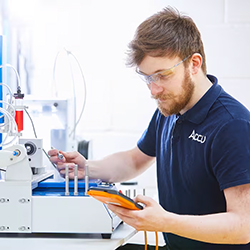How practical, technology-driven advancements led to the development of the world’s first multi-articulating robotic prosthetic hand.
Patrick Faulkner, Lead Engineer at Accu, looks at how an entrepreneur’s life changing accident led to the development of the world’s first water resistant robotic prosthetic hand, powered by precision engineering solutions.
“In the field of engineering, some of the most remarkable innovations emerge from necessity, where a pressing challenge ignites the creativity and determination needed to develop groundbreaking solutions.
At the heart of these innovations is a commitment to creating practical, technology-driven advancements that enhance lives. A prime example of this is the TASKA Hand — the world’s first water-resistant, multi-articulating robotic prosthetic hand.
What sets this innovation apart isn’t just the cutting-edge technology but the deeply personal story that drove its creation. TASKA Prosthetics, a New Zealand-based company, was founded by Mat Jury, an inventor and engineer. After breaking both of his arms in a mountain biking accident, Mat gained first hand insight into the everyday struggles faced by people with limb differences. This ignited his passion for creating prosthetics that do more than just replace a missing limb, but restore confidence and functionality to users’ lives.

A prosthetic hand isn’t just a medical device—it needs to be robust, adaptable and practical enough for daily life. When developing the TASKA Hand, Mat and his team of engineers set out to solve the problems that plagued existing prosthetic hands: awkward usability, fragility and a lack of flexibility. This meant every component had to meet strict requirements for durability and performance.
Our design/R&D team had the privilege of supporting this vision by providing precision-engineered components for the TASKA Hand. For this prosthetic to truly make a difference, it needed to be lightweight yet incredibly durable, capable of enduring the wear and tear of daily tasks without compromising performance. Our team carefully selected components that would enable the hand to function reliably under a wide array of conditions.
One key challenge was ensuring the prosthetic was waterproof. TASKA wanted to create the most advanced prosthetic hand on the market that could be used in everyday life without requiring the user to remove it when engaging in tasks like washing dishes, showering, or even swimming. This meant selecting materials and fasteners with exceptional corrosion resistance to prevent degradation when exposed to water. Using stainless steel socket cap screws and Torx countersunk screws, we ensured the components were water resistant, maintaining the hand’s performance even in wet environments.
TASKA’s design philosophy centres around real-world practicality. The designers sought to create a hand that was not only functional but also intuitive and comfortable for users. With high-quality components and thoughtful design, the TASKA Hand offers superior articulation and responsiveness, enabling users to perform everyday tasks, like opening a bottle or shaking hands, with ease and confidence.
The design process was also guided by a strong focus on user feedback. TASKA worked closely with a global network of users, clinicians and experts to refine the hand’s functionality. In particular, the team paid close attention to vibrations and how these could affect the prosthetic’s long-term performance. To address this, the team incorporated anti-vibration components, such as nylon locking nuts and special anti-vibration screws, to minimise the impact of daily use.
What makes the TASKA Hand truly remarkable is its ability to empower users to live more independently, doing things they never thought possible. The team’s innovative approach is not just about creating a functional device but designing a prosthetic that enhances the quality of life for those who use it. The tagline “do more” perfectly encapsulates this philosophy: the goal is not just to replace a limb but to enable people to explore new possibilities and push boundaries.
The success of the TASKA Hand is testament to the power of collaboration between engineers, designers and users. The ability to develop high-performance prosthetics requires more than just technical expertise—it takes a deep understanding of the challenges faced by those living with a disability and a commitment to improving their lives. As engineers, we strive to not only solve problems but to create solutions that will have a lasting impact.
As we continue to push the boundaries of innovation, it’s clear that the lessons learned from projects like this will have far-reaching implications. Precision engineering, when applied to real-world problems, can change lives in profound ways. The advances we make in medical devices, prosthetics and other technologies today pave the way for new possibilities in the future.
Visit Accu for more information, call 01484 937010 or email: sales@accu.co.uk.

About the Author:
Patrick Faulkner is the Lead Engineer at Accu, a supplier of precision engineering components. With years of experience in providing high-performance solutions, Patrick works closely with clients in a range of industries, from prosthetics to aerospace, to help bring innovative ideas to life.
In this episode, I sat down with Beejan Giga, Director | Partner and Caleb Emerson, Senior Results Manager at Carpedia International. We discussed the insights behind their recent Industry Today article, “Thinking Three Moves Ahead” and together we explored how manufacturers can plan more strategically, align with their suppliers, and build the operational discipline needed to support intentional, sustainable growth. It was a conversation packed with practical perspectives on navigating a fast-changing industry landscape.